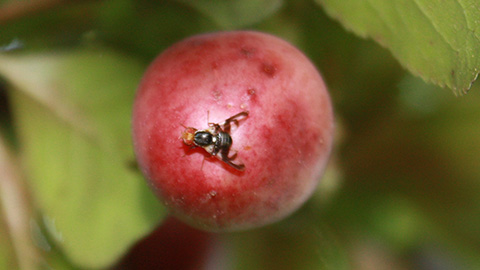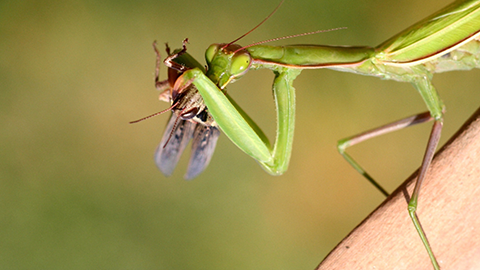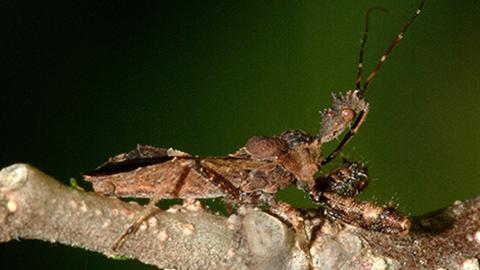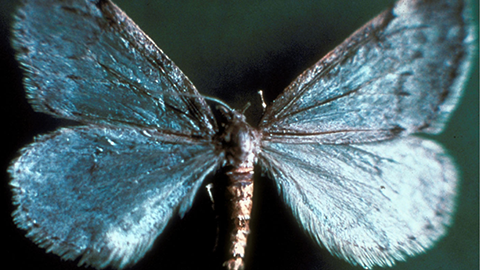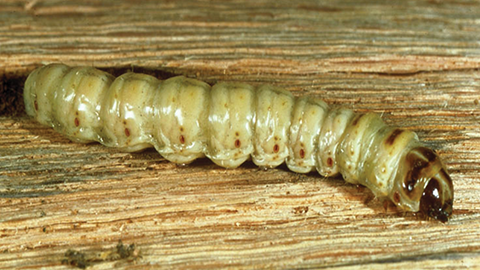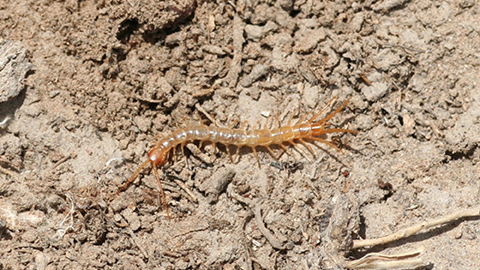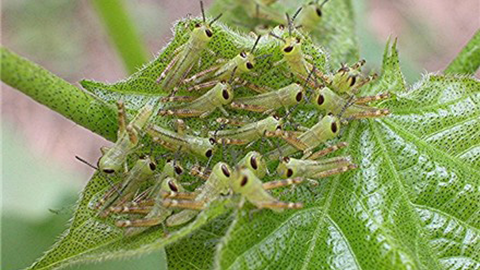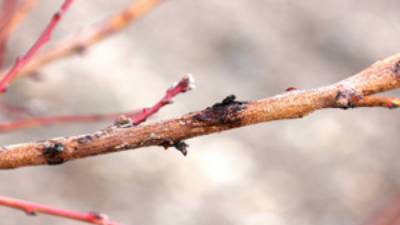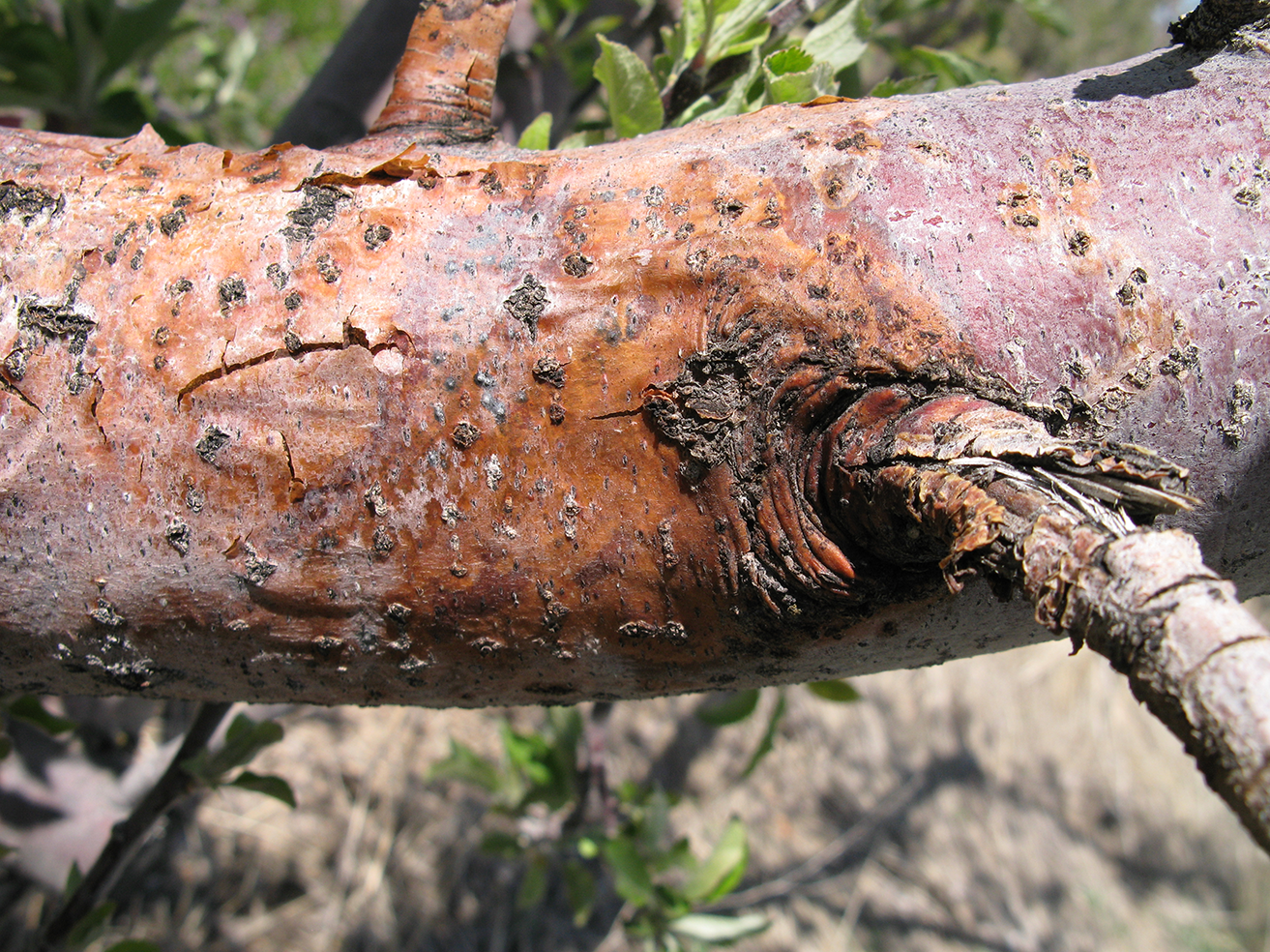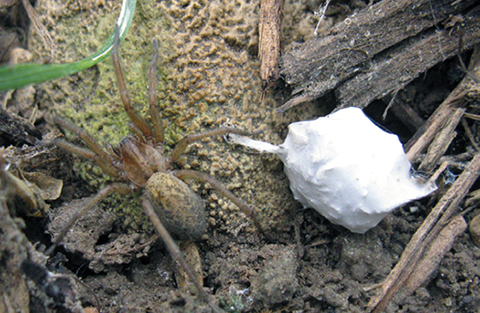Billbugs in Turfgrass
March 2022
Desireè Wickwar, USU Department of Biology (No longer at USU) • Ricardo Ramirez, Extension Entomologist (No longer at USU)

Fig. 1. Billbug adults have a long, curved snout. Bluegrass billbug is a smaller species, about 1/4 inch (7mm) long, black to dark brown, with uniform pitting on the thorax. Hunting billbug is about 1/3 inch (8–11mm) long, and is red-brown in color with a slightly raised, smooth “( Y )” shaped area on the thorax. Rocky Mountain billbug is the largest of this species complex, about 1/2 inch (12mm) long, and is black with lighter “U” shaped pits running longitudinally on their forewing. Image courtesy of Desireè Wickwar, Utah State University.

Fig. 2. Billbug larva. Image courtesy of Desireè Wickwar, Utah State University.

Fig. 3. The exact timing of billbug development varies based on seasonal conditions, but adults generally emerge from overwintering in March and April, peaking in abundance from early to mid-June. Eggs are deposited within grass stems which quickly hatch into larvae. Larger larvae that inflict damage to turfgrasses peak in late summer, July and August. Larvae pupate and emerge as adults that will overwinter until the following year. Image courtesy of Desireè Wickwar, Utah State University.

Fig. 4. Billbugs cause brown/yellow patches to develop in turfgrasses. This damage is most common and most severe in the mid to late summer. Image courtesy of David Shetlar, The Ohio State University.

Fig. 5. Billbug feeding on the crown and root of turfgrasses causes it to break off when tugged upward, revealing hollowed stems and sawdust-like excrement. Image courtesy of Douglas Richmond, Purdue University.
Quick Facts
- Billbugs feed on the roots of grasses, affecting both cool and warm season turfgrasses.
- Billbug larvae can cause the development of large dead patches in grass.
- Billbug damage peaks in mid to late summer.
- Monitoring adult billbugs using pitfall traps and larvae using the “tug test” is key for effective management.
- Proper irrigation and fertilization can effectively conceal mild to moderate billbug infestation.
- Severe damage can be prevented through a correctly timed application of insecticides.
Introduction
Billbugs are weevils, a type of beetle, in the genus Sphenophorus. At least 10 billbug species are known pests of turfgrass and can be found in both warm and cool season turfgrasses throughout the United States. Though billbug adults do feed on the leaves of turfgrasses, it is the larvae that cause visible damage. Larvae feed within the stems and on roots of grasses, leading to the development of yellow or brown patches, with the potential to escalate into large patches of dead turfgrass. Billbug management in turfgrass presents a number of unique challenges, but early monitoring and informed integration of multiple strategies can help mitigate these challenges, and proper turfgrass management can help conceal mild to moderate levels of billbug damage.
Identification
Adults have a distinctive curved “snout” and elbowed antennae with small clubs at the end (Fig. 1). Adults are 1/4–1/2 inch (7–12mm) in length, and range in color from black to red-brown. Adult billbugs are flightless but are highly mobile and often observed in short-mown areas or on sidewalks on warm days.
Larvae are white/cream colored, legless, with a red-brown head capsule (Fig. 2). Larvae range from 1/25–1/3 inch (1mm–8mm) in length, depending on the stage of development. Larvae are visually indistinguishable among the billbug species. Early life stages (~1/25 inch) live within grass stems. Later life stages (up to 1/3 inch) live in the top few inches of soil, feeding on crowns and roots. Billbug larvae can resemble white grubs, another root-feeding beetle larva. However, billbug larvae are white and legless, while white grubs are off-white with three pairs of legs.
Billbug Lifecycle
Billbugs overwinter as adults in sheltered areas such as leaf litter and in unmanaged vegetation. Adults become active in spring as temperatures warm. Adults mate and deposit eggs (~1mm) in grass stems. Eggs hatch and larvae begin their development still enclosed in the grass stem, where they feed. Later stage larvae drop out of the stem and into the root zone, where they feed on the crowns and roots of turfgrasses. Larvae pupate in the soil and emerge as adults in late summer and early fall. These adults then seek sheltered overwintering locations and will emerge the following spring to begin the cycle anew. Though billbugs generally are thought to only have one generation per year in Utah, recent research suggests the possibility of a partial second generation, with some larvae overwintering as well (Fig. 3).
Plant Hosts and Damage
Billbugs are specialists on grasses, with the ability to infest many grass species. Though they can infest non-turf grass types (i.e., corn, barley, and rye), they are the most problematic in turfgrasses. Billbugs can infest many different turfgrasses, both cool season turf (i.e., Kentucky bluegrass, ryegrass, fescues, and bentgrass) and warm season turf (i.e., zoysiagrass and bermudagrass).
Billbug damage can appear in early summer as the larvae feed within the grass stems, hollowing them out and causing localized discoloration. However, the most severe, widespread damage appears due to the feeding of late-stage larvae on turfgrass roots, leading to the spread of yellow/brown patches of turf (Fig. 4).
Billbug damage is often mistaken for drought stress. However, billbug damage and drought damage may co-occur, as billbugs are more abundant in areas with low soil moisture. Furthermore, drought-susceptible Kentucky bluegrass cultivars appear to be more susceptible to billbug damage than drought-tolerant cultivars. This means that dry and drought-stressed areas may be more likely to suffer serious billbug damage. Fortunately, simple monitoring techniques and recognition of the hallmarks of billbug infestation can help to diagnose billbug problems and guide treatment.
Monitoring
Early spring detection of billbugs focuses on monitoring adult activity. This can be achieved through pitfall trapping. The simplest pitfall traps can be constructed from two nested cups, buried to the lip in the soil. Linear pitfall traps are more elaborate traps that consist of a buried length of pipe with a slit cut in it lengthwise, running into a collection cup. Though more difficult to establish, these linear pitfall traps can aid in multi-year monitoring efforts. Frequent collections from these traps can also provide a systematic way to monitor the change in billbug activity from week to week.
A predictive model is available through the Utah TRAPs site to help billbug monitoring efforts. Here, a model uses daily high and low temperatures to predict the timing of billbug emergence and progression through life stages by counting accumulated degree days (DDs) or days above 3° C after January 13 (see the chemical control section for details). With the first emergence you can begin to check traps or simply watch for billbugs on sidewalks and driveways.
One of the easiest monitoring methods to detect larvae is the “tug test.” If damaged turf breaks off at the crown when tugged upward, revealing sawdust-like frass (insect excrement) within hollow stems, it is likely that billbug infestation is the root cause of the problem (Fig. 5).
When larvae are no longer concealed in grass stems, a trowel or a golf course cup cutter can be used to pull out a plug in areas where infestation is suspected and check for larvae in the thatch and top few inches of soil. If an average of one or more larvae are found per cup cutter sample, the established treatment threshold will have been reached, and management is recommended to avoid significant turfgrass damage.
Management Strategies
Cultural Control
Implementing cultural practices that reduce the ability of billbugs to establish, reproduce, or survive is an important element of billbug management. Efforts often focus on the planting of specific cultivars that are less favorable for billbugs. For instance, endophytes, a type of fungus that grows within some perennial ryegrasses and fescues (aka endophyte-enhanced turfgrasses) may reduce billbug feeding and damage. Though Kentucky bluegrass does not have these endophytes, there is evidence that planting it with a mix of endophyte-enhanced turfgrasses is still beneficial.
Healthy, vigorously growing grasses can also show less billbug damage, so following recommendations concerning irrigation and fertilization for the area are important. Check to make sure sprinklers are functioning properly, with good coverage. Selection of drought- and heat-stress-tolerant cultivars can help drought-prone areas as well, and data suggests that drought-resistant Kentucky bluegrass cultivars suffer less billbug damage. These cultivars can help ensure that stress is minimized, without necessitating costly increases in irrigation or fertilization. Ask seed or sod producers about endophyte-enhanced or stress-tolerant cultivars.
Biological Control

Fig. 6. Pterostichus melanarius is the most common of the many species of predatory ground beetles in turfgrass. Image courtesy of Desireè Wickwar, Utah State University.
Predators, parasites, and pathogens of pests can suppress pest outbreaks. Turfgrass hosts a diverse group of insect predators, such as ground beetles (Fig. 6), rove beetles, and ants as well as some spiders, that eat many turfgrass pests. For billbug adults specifically, it appears that the feeding of these predators is a very small component of their suppression. However, research suggests that billbugs change their behavior in the presence of predators in ways that might reduce their overall health and population size. Therefore, conservation of predator populations is key and can be achieved by fostering diverse plantings of native perennials and flowering plants adjacent to turfgrass. Reducing insecticide use or using more selective insecticides whenever possible will also help conserve natural predators.
Applications of microbial agents may also aid in suppressing billbug larvae. Insect pathogens (entomopathogens) including entomopathogenic nematodes and fungi have been shown to target soil-dwelling larvae, though their use against billbugs is limited. Products such as Biosafe®, Biovector® and Exhibit® contain the entomopathogenic nematode Steinernema carpocapsae, which is associated with a bacterium that kills insects. One of the more widely used entomopathogenic fungi species is Beauveria bassiana, which is found in the product Naturalis®. Consider these precautions in applying these products: avoid applying during hot, sunny conditions, and irrigate before and after application. Check the expiration date of products before use, and follow label recommendations and recognize that several applications may be necessary to achieve acceptable levels of control.
Chemical Control
Multiple chemical insecticides are labeled for use in turfgrass that target adults and larvae (Table 1):

Note: Recognize that this is not an exhaustive list. To reduce the risk of evolved resistance to insecticides, rotate insecticides with different group numbers. The group number corresponds to a unique mode of action, or how the pesticide effects/kills a pest. For instance, insecticides in group 3A act on the sodium channels of the pest nervous system. “UN” indicates an unknown mode of action.
Contact insecticides, such as pyrethroids, can be used to target spring adult billbugs before they lay eggs. However, a challenge is that adults are mobile and insecticides with short residuals have a limited capacity to suppress any additional influx of adults.
Systemic insecticides, those that are absorbed/translocated within the plant, primarily target larvae developing within the stems or feeding on the roots of turfgrass. Neonicotinoids and diamides are two classes of systemic insecticides with longer residual activity. As the larvae feed on the plant, the insecticide is ingested. To target early stage larvae in stems, these products should be applied ahead of eggs hatching to allow the product to translocate throughout the plant before feeding occurs. The billbug degree day model suggests that systemic insecticides should be applied when 30% of the adult population has emerged, and are effective in treating larvae from 560–625 DD.
Some systemic insecticides, particularly neonicotinoids, also have contact activity and can suppress adults too. Therefore, curative treatments should occur before 50% adult emergence or 925–1485DD.
Benefits of suppression with insecticides diminish as adult emergence approaches peak activity. Note that contact insecticides (i.e., pyrethroids) tend to be less effective against larvae in stems and within the soil. To minimize ongoing damage by established larvae, water soluble systemic insecticides appear to provide suppression. However, efficacy of these insecticides in targeting large, soil-dwelling larvae may be reduced compared to the younger larvae in stems due to shielding by soil or thatch.
References
- Dupuy, M. M., & Ramirez R. A. (2016). Biology and management of billbugs (Coleoptera: Curculionidae) in turfgrass. Journal of Integrated Pest Management, 7, 1–10.
- Held, D.W., & Potter, D.A. (2012). Prospects for managing turfgrass pests with reduced chemical inputs. Annual Review of Entomology, 57, 329–354.
Related Research



